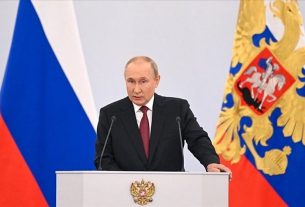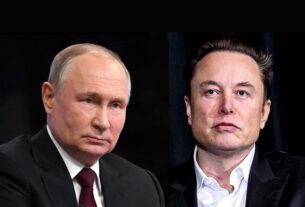Thu 31 March 2022:
Mumbai, India–Indian authorities are actively considering dedicated payment mechanisms for trade with Russia to enable existing trade obligations in the wake of sanctions imposed on the Kremlin, a move that will also pave the way for cheaper oil imports to meet the country’s energy demands.
In the past month, as sanctions have been imposed on Russia, the scope of a payment mechanism in local currencies has expanded from being a means to sustain ongoing trade to possibilities of deeper engagement, including increasing bilateral trade.
For the rupee-rouble mechanism to be implemented, Indian importers would pay for goods to the accounts of Russian banks in India and they in turn would make the payment in roubles to the Russian exporters. But since India’s imports outweigh its exports, the only way the Russian banks can get rid of their piled up rupees is if India exports more, experts say, opening up an opportunity for manufacturers of agricultural machinery, medicine, furniture and bathroom fittings, among other goods, who are looking for new markets.
“We need to be aware of where Russia would want to look at import substitution,” said Nandan Unnikrishnan, distinguished fellow at the Observer Research Foundation (ORF). Some of those exports will come from India’s medium and small industries who can also look at setting up units in Russia, he added. “They don’t have a lot of experience with SMEs [Small Medium Enterprises] and we have a huge amount of experience there that we could share practically and on the ground.”
Cheap Russian oil
India imports 86 percent of its oil requirements. On Tuesday, India’s crude oil basket was priced at $109 per barrel for its crude imports. While down from $128.24 per barrel earlier in the month, it was still up from $95.47 per barrel the day before the Russian invasion. The sharp rise in oil prices since the start of the Russian invasion will widen India’s gaping current account deficit and push inflation higher, eroding the value of the domestic currency.
While India gets only a tiny 2 percent from Russia, it can ramp up those purchases, and reportedly has already started to do that given Russia’s offer to sell at a discounted rate and bear the cost of transportation and insurance. The prospect of cheaper supplies from Russia would no doubt help New Delhi manage its finances better.
Currently, India’s trade with Russia is largely skewed towards imports — which is why the country maintains a substantial trade deficit. According to Indian government data, the two countries had bilateral trade amounting to $8.1bn during the financial year April 2020 through March 2021, where Indian exports were at $2.6bn while imports from Russia were at $5.48bn.
This bias will remain and may tilt more in the direction of imports especially if it increases its purchases of oil from Russia. Unless, of course, India ramps up exports.
“The exporter community is definitely looking at opportunities that are going to come [along] the way,” said Ajai Sahai, director general and chief executive of industry body the Federation of Indian Export Organisation.
However, he cautioned, Indian banks are averse to backing trade with Russia even on goods that are allowed under the sanctions. To circumvent those troubles, FIEO has submitted a proposal to India’s Ministry of Commerce suggesting a rupee-rouble mechanism as well as a rupee-based trade mechanism where the contract is made in the local currency, the rupee, and the other party bears the exchange rate risk.
Lessons from the past
The trade mechanism currently being discussed dates back three decades when India and the then Soviet Union had agreed to transact in the domestic currencies at an agreed-upon, fixed rate for government-to-government transactions. This was done to bypass the United States dollar as a “vehicle currency” — the currency in which most trade is done — during the Cold War.
Now with several Russian banks having been cut off from the international financial messaging system, SWIFT, Russian businesses have a much tougher task to make and receive payments for trade as they are primarily denominated in US dollars.
The Indian government is reportedly considering alternative methods of exchange to ensure that receivables of Indian exporters against sales to Russia that are stuck are cleared. On Wednesday Bloomberg News reported that the Indian government is considering a proposal from Russia to use a system developed by the Central Bank of Russia for bilateral payments.
In the event a rupee-rouble mechanism is brought into place, analysts believe it is more likely to be at a rate determined by markets as opposed to a fixed rate since this will not be for trade between two governments, but for trade between businesses of the two countries.
“In 1993 and 2003, that was a government-to-government transaction for military purposes or for bilateral loans. There, the rate was completely artificial and it was completely against India,” said Ananth Narayan, associate professor at the S P Jain Institute of Management and Research.
“Initially the rouble was set at an artificial rate and then the rate collapsed after the Soviet Union collapsed, but we still honoured the old rate… It was possible to ignore market rates because it was a government-to-government transaction and there were bigger things at stake, including military cooperation and geopolitical considerations. In a commercial importer and exporter transaction, why agree to some artificial rate?”
Challenges ahead
However, it won’t be that easy for India to implement this rupee-rouble mechanism, experts warn.
The biggest stumbling block will be how to decide upon a rate of exchange against the Russian rouble that has been so volatile since the beginning of the war. It is also not viable to peg the rouble and the rupee even against a third currency for trade.
Then, even if the two countries were to agree on a rate of exchange, the trade deficit will still be largely skewed towards Indian imports from Russia, especially with oil imports going up. And it is only a matter of time before Indian authorities would have to devise a way to remit the balance of trade and potentially come up against the sanctions.
The last and the most important concern would be that of geopolitical strategy. So far, India has maintained a neutral position on the Ukraine-Russia war by abstaining to vote three times at the United Nations on resolutions against Russia on its invasion and once on a vote brought by Russia on the humanitarian crisis in Ukraine.
But how far will India be willing to engage with Russia before the US objects? US President Joe Biden has already pointed out that of all of the countries in the Quadrilateral Security Dialogue — the US, Japan Australia and India — India has been “somewhat shaky” in showing support to Ukraine on the Russian invasion.
“At this point, it does not appear as if the Indian government is considering for a single moment abandoning the Russia ship and switching over completely to the US ship. I think the Indian government intends to use both equally,” ORF’s Unnikrishnan said.
“Our trade with the West far outweighs what the Russians can get from us. So naturally, our industry and financiers are going to look at Russia as a potential market but won’t do anything that would in any sense shake their relationship with the Western market, which is our primary source of wellbeing at this point in time,” he added.
For now, trade importers and exporters continue to do business with Russia in dollar terms. Experts say that the mechanism may be looked at as a contingency plan to trigger if sanctions on Russia were to become more stringent. However, at this point, the risks of actively pursuing deeper bilateral trade with Russia could mean geopolitical ramifications for India.
By
___________________________________________________________________________________________________________________________________________
FOLLOW INDEPENDENT PRESS:
TWITTER (CLICK HERE)
https://twitter.com/IpIndependent
FACEBOOK (CLICK HERE)
https://web.facebook.com/ipindependent
Think your friends would be interested? Share this story!





